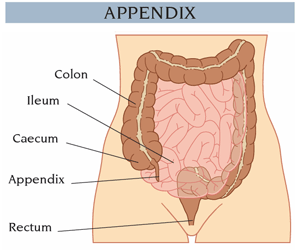Appendicitis |
Basic Information
What is Appendicitis?
Inflammation of the vermiform appendix, a small intestinal pouch that extends from the cecum, the first part of the large intestine. The appendix has no known function, but it can become diseased. Appendicitis affects 1 in 500 people each year. Symptoms vary widely. Appendicitis should be considered in any person with undiagnosed abdominal pain. It affects all ages (men more than women), but is rare in children under 2. The incidence peaks between ages 15 and 24.
Appendicitis signs and symptoms

- Pain that begins close to the navel and migrates toward the right lower abdomen. Pain becomes persistent and well-localized. It worsens with moving, breathing deeply, coughing, sneezing, walking or being touched.
- Nausea and sometimes vomiting.
- Constipation and inability to pass gas.
- Diarrhea (occasionally).
- Low fever, beginning after other symptoms.
- Tenderness in the right lower abdomen, usually about a third of the distance from the navel to the top of the hip bone. (This description applies only if the appendix is in its normal position. In some cases, the tip of the appendix is located elsewhere, making diagnosis difficult).
- Abdominal swelling (late stages).
- Increased white-blood-cell count.
Causes
Infection for unknown reason, usually with bacteria from the intestinal tract. The appendix may become obstructed from contents moving through the intestinal tract or by a constricting band of tissue. When infected, it becomes swollen, inflamed and filled with pus.
Risk increases with
Recent illness, especially a roundworm infestation or gastrointestinal virus infection.
Preventive measures
No specific preventive measures.
Expected outcomes
Usually curable with surgery. If totally untreated, a ruptured appendix is fatal.
Possible complications
- Rupture of the appendix, abscess formation and peritonitis. This is more common in older persons.
- Misdiagnosis because of few or atypical symptoms, especially in the very young or very old.
- Formation of an abscess.
Appendicitis treatment
General measures
- Diagnostic tests may include laboratory blood studies (show higher levels of white blood cells) and urinalysis to rule out a urinary-tract infection, which can mimic appendicitis.
- While diagnosis is uncertain, take a rectal temperature every 2 hours. Keep a record.
- Surgery to remove the appendix (appendectomy). Because appendicitis can be hard to diagnose, surgery is often withheld until symptoms and signs progress enough to confirm the diagnosis.
- If an abscess has formed, surgery may be delayed until the abscess is drained and has time to heal.
Medications
- Don't take any laxatives, enemas or medicines for pain. Laxatives may cause rupture, and pain or fever reducers make diagnosis more difficult.
- Pain medicine will be prescribed after surgery.
- Antibiotics if infection is present.
- Stool softeners to prevent constipation may be recommended.
Activity
- Rest in a bed or chair until surgery.
- Resume normal activities gradually after surgery.
Diet
- Don't eat or drink anything until appendicitis has been diagnosed. Anesthesia for surgery is much safer if the stomach is empty. If you are very thirsty, wash your mouth out with water.
- A liquid diet, progressing to soft diet following surgery.
Notify your physician if
- You or a family member has symptoms of appendicitis.
- The following occur while surgery is pending or after
surgery:
- Fever of 102°F (38.9° C) or over.
- Continued vomiting.
- Increased pain in the abdomen.
- Fainting.
- Blood in the stool or vomit.
- Dizziness or headache.
Last updated 10 May 2016
